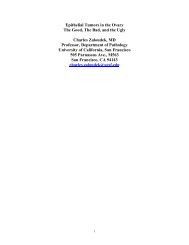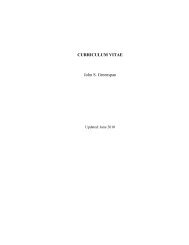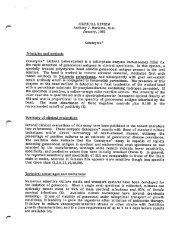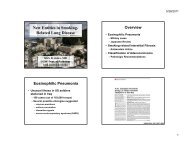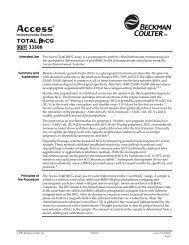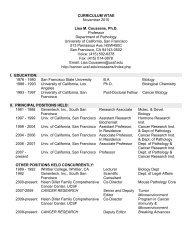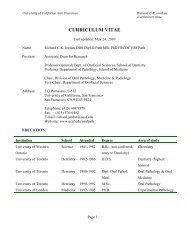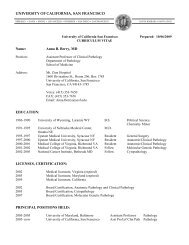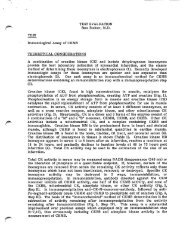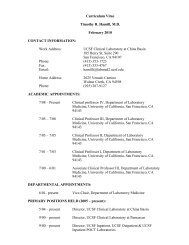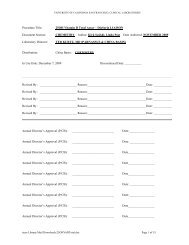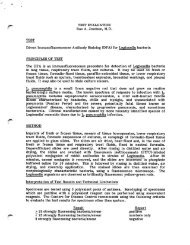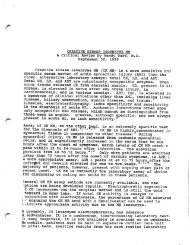Procedure
Procedure
Procedure
You also want an ePaper? Increase the reach of your titles
YUMPU automatically turns print PDFs into web optimized ePapers that Google loves.
Principle of the Test<br />
Ferritin<br />
ADVIA Centaur System<br />
The ADVIA Centaur ® Ferritin assay is a two-site sandwich immunoassay using direct chemiluminometric<br />
technology, which uses constant amounts of two anti-ferritin antibodies. The first antibody, in the Lite<br />
Reagent, is a polyclonal goat anti-ferritin antibody labeled with acridinium ester. The second antibody, in<br />
the Solid Phase, is a monoclonal mouse anti-ferritin antibody, which is covalently coupled to<br />
paramagnetic particles.<br />
The system automatically performs the following steps:<br />
• dispenses 25 µL of sample into a cuvette<br />
• dispenses 100 µL of Lite Reagent and 450 µL of Solid Phase and incubates for 7.5 minutes at 37°C<br />
• separates, aspirates, and washes the cuvettes with reagent water<br />
• dispenses 300 µL each of Acid Reagent and Base Reagent to initiate the chemiluminescent reaction<br />
• reports results according to the selected option, as described in the system operating instructions or in<br />
the online help system<br />
A direct relationship exists between the amount of ferritin present in the patient sample and the amount of<br />
relative light units (RLUs) detected by the system.<br />
Clinical Application and Usefulness<br />
For in vitro diagnostic use in the quantitative determination of ferritin in serum or plasma using the<br />
ADVIA Centaur System, to aid in the diagnosis of iron deficiency anemia and iron overload.<br />
Specimen Collection and Handling<br />
Specimen Collection<br />
BIOHAZARD<br />
All products or objects that come in contact with human or animal body fluids should<br />
be handled, before and after cleaning, as if capable of transmitting infectious diseases.<br />
Wear facial protection, gloves, and protective clothing.<br />
• Serum or heparinized plasma are the recommended sample types for this assay.<br />
• NOTE: Evaluation of plasma samples showed an average 5% decrease in observed values compared to<br />
serum samples.<br />
• This assay requires 25 µL of sample for a single determination. Additional volume is required for<br />
onboard dilutions.<br />
UCSF Clinical Labs-Chemistry 1 of 12 Proc\Centaur\Ferritin
• Allow serum samples to clot adequately before centrifugation.<br />
• Samples are free of fibrin or other particulate matter.<br />
• Samples are free of bubbles.<br />
Specimen Storage and Stability<br />
• Do not use samples that have been stored at room temperature for longer than 8 hours.<br />
• Tightly cover and refrigerate specimens at 2 to 8°C if the assay is not completed within 48 hours.<br />
• Freeze samples at or below -20°C if the sample is not assayed within 48 hours.<br />
• Freeze samples only once and mix thoroughly after thawing.<br />
Reagents<br />
Storage and Stability<br />
• Store the reagents upright at 2–8 °C.<br />
• Primary reagents stable until the expiration date on the pack label, or for 28 days onboard the system.<br />
• Diluent stable until the expiration date on the pack label, or for 28 consecutive days after accessing<br />
the ancillary reagent pack.<br />
CAUTION:<br />
• Discard the primary reagent packs at the end of the onboard stability interval.<br />
• Do not use reagents beyond the expiration date.<br />
Ingredients<br />
Reagent ingredients for the ADVIA Centaur Ferritin assay are as follows:<br />
Reagent Volume Ingredients<br />
Lite Reagent 5.0 mL/ReadyPack ®<br />
polyclonal goat anti-ferritin antibody (~0.64 µg/mL)<br />
labeled with acridinium ester in HEPES buffer with<br />
protein stabilizers, sodium azide (< 0.1%), and<br />
preservatives<br />
Solid Phase 22.5 mL/ReadyPack monoclonal mouse anti-ferritin antibody (~32.2 µg/<br />
mL) covalently coupled to paramagnetic particles in<br />
sodium barbital buffer with protein stabilizers, sodium<br />
azide (< 0.1%), and preservatives<br />
Multi-Diluent 1 25.0 mL/ReadyPack equine serum with sodium azide (0.1%) and<br />
preservatives<br />
UCSF Clinical Labs-Chemistry 2 of 12 Proc\Centaur\Ferritin
WARNING: Sodium azide can react with copper and lead plumbing to form explosive metal azides. On<br />
disposal, flush reagents with a large volume of water to prevent the buildup of azides, if disposal into a<br />
drain is in compliance with federal, state, and local requirements.<br />
BIOHAZARD<br />
All products or objects that come in contact with human or animal body fluids should<br />
be handled, before and after cleaning, as if capable of transmitting infectious diseases.<br />
Wear facial protection, gloves, and protective clothing.<br />
Reagents Special Preparation<br />
No special preparation of reagents is required.<br />
Calibration<br />
For detailed procedural information about scheduling a calibration, refer to the ADVIA Centaur<br />
Reference Manual or to the online help system.<br />
Two-point Calibration Interval<br />
Use Calibrator C to perform two-point calibrations.<br />
Perform a two-point calibration every 28 days. Additionally, calibrate when the following conditions<br />
occur:<br />
• the lot numbers of the primary reagent packs have changed<br />
• system components are repaired or replaced<br />
• quality control results do not fall within established ranges<br />
Defining Calibrator Values for Two-point Calibration<br />
1. At the workspace, select Calibration.<br />
2. Select Calibrator Definition.<br />
3. Select Scan Data.<br />
4. Scan the barcodes on the Calibrator Assigned Value Card.<br />
5. Define the LIS field.<br />
6. Review the values on the Calibrator Assigned Value card to ensure that they are correct. Scan again,<br />
if required.<br />
7. Select Save.<br />
UCSF Clinical Labs-Chemistry 3 of 12 Proc\Centaur\Ferritin
Master Curve<br />
Use the barcode reader to enter the Master Curve values from the Master Curve card onto the system.<br />
Ensure that the lot number on the Master Curve matches the lot number of the ReadyPack.<br />
Defining the Master Curve Using the Barcode Scanner<br />
1. At the workspace, select Calibration.<br />
2. Select Master Curve Definition.<br />
3. At the Calibration-Master Curve Definition window, select Scan Data.<br />
4. Scan the barcodes on the Ferritin Master Curve Card.<br />
5. Select Save.<br />
Quality Control (QC)<br />
BioRad Lyphochek Anemia control.<br />
Reconstitute with 3.0 mL Reagent water. The reconstituted control is stable for 14 days when stored at<br />
2-8 °C.<br />
BioRad Immunoassay Plus Control levels 2 & 3<br />
Each control is reconstituted with 5.0 mL of Reagent water. The reconstituted controls are stable for<br />
7 days when stored at 2-8 °C.<br />
See posted QC chart for acceptability limits.<br />
QC Frequency<br />
Analyze all three levels of quality control material on each day that samples are analyzed.<br />
Analyze all three levels of quality control material each time a two-point calibration is performed.<br />
Troubleshooting Out-of-Range QC Values<br />
A QC run is acceptable when all values fall within the expected ranges.<br />
If the Ferritin QC results do not fall within the defined ranges then the run is rejected, and you must take<br />
the following corrective action:<br />
• review these instructions to ensure that the assay was performed according to the procedures<br />
recommended by Bayer Diagnostics<br />
• verify that the materials are not expired<br />
• verify that required maintenance was performed<br />
• if necessary, recalibrate the system and then rerun the quality control samples or contact<br />
Bayer Diagnostics for more assistance<br />
UCSF Clinical Labs-Chemistry 4 of 12 Proc\Centaur\Ferritin
Instrument Operation and System Description<br />
The ADVIA Centaur system is an automated, random access, direct chemiluminescent immunoassay<br />
analyzer that offers no-pause reloading of reagents, samples, and supplies. Comprehensive assay groups<br />
are available.<br />
When the sample start button is pressed, the barcode labels on the sample cups are read, sample is<br />
aspirated, reagent is dispensed, and the assay process begins. Paramagnetic particles are magnetically<br />
separated in the cuvette incubation ring. The addition of hydroxyl groups to complete the flash reaction is<br />
accomplished by the addition of Acid and Base. The chemiluminescent reaction occurs in the<br />
luminometer. The PMT measures the chemical light reaction that takes place.<br />
Refer to Section 4 in the ADVIA Centaur Reference Manual for detailed procedures that describe how to schedule<br />
samples and manage the worklist.<br />
A. System Start Button<br />
There is one (1) main system operation button on the ADVIA Centaur, the Start button. Pressing this<br />
button performs the following actions:<br />
• Homes the subsystems.<br />
• Starts specimen sampling.<br />
• If the Start button is pressed while the system is processing samples, it stops sampling additional<br />
specimens, however it continues to process the specimens in the incubation ring.<br />
B. Start-up<br />
1. Put the samples racks on the sample entry queue.<br />
2. Press the Start button.<br />
C. Verify Supplies:<br />
While the system is running, you can manage the following supplies without interrupting the run.<br />
• Reagent water supply<br />
• Liquid waste container<br />
• Acid and Base reagents<br />
• Cuvette waste bin<br />
• Sample tip waste bin and tip tray waste area<br />
• Cuvette supply<br />
• Sample tip supply<br />
• Ancillary reagent packs<br />
• Primary reagent packs<br />
UCSF Clinical Labs-Chemistry 5 of 12 Proc\Centaur\Ferritin
D. Scheduling a Run/Entering a Worklist<br />
You can enter a worklist by different methods:<br />
Automated Worklist<br />
You can send the worklist to the ADVIA Centaur from a Lab Information System (LIS). This is done in a<br />
unidirectional manner (Dynamic Download) or in a bi-directional manner (Host Query).<br />
Manual (Operator-initiated) Worklist<br />
Scheduling Calibrators<br />
1. At the workspace, select Worklist and then select Schedule.<br />
2. Select the Calibrator box.<br />
3. Select the test you want to schedule for calibration.<br />
4. The reagent lot that is on the system and any defined calibrators are displayed. Select the<br />
appropriate reagent and calibrator lot combination.<br />
5. Select Save.<br />
6. Ensure that the lot numbers of reagent and calibrator are available for system use.<br />
Scheduling Controls<br />
1. At the workspace, select Worklist and then select Schedule.<br />
2. Select the Control box.<br />
3. Select each test you would like to schedule.<br />
4. Select each control level and lot number you need to run.<br />
5. Select Save.<br />
Scheduling Patient Samples<br />
1. At the workspace, select Worklist and then select Schedule.<br />
2. Select the Patient box.<br />
3. Enter a patient sample identification number (SID).<br />
4. Press the Enter key.<br />
5. Select each test, profile, dilution, and/or replicates needed.<br />
6. Select Save.<br />
For detailed operating procedural information, refer to the ADVIA Centaur Reference Manual or to the<br />
online help system.<br />
UCSF Clinical Labs-Chemistry 6 of 12 Proc\Centaur\Ferritin
E. Loading Sample Racks<br />
BIOHAZARD<br />
All products or objects that come in contact with human or animal body fluids should<br />
be handled, before and after cleaning, as if capable of transmitting infectious diseases.<br />
Wear facial protection, gloves, and protective clothing.<br />
CAUTION: Do not load more than one size of sample container in each rack. The rack indicator must be<br />
positioned at the correct setting for the size of sample container.<br />
1. Gently mix the calibrators and quality controls before dispensing into the sample cups.<br />
2. Load the sample cups containing the calibrators, controls, or patient specimen into any Centaur<br />
rack.<br />
3. Load racks onto the sample entry queue.<br />
4. Press the Start button.<br />
F. Loading Ancillary Reagents<br />
Place the ancillary reagent pack on the ancillary entry queue until the green light comes on. The ADVIA<br />
Centaur moves the pack into the ancillary queue.<br />
G. Loading Primary Reagents<br />
CAUTION: Mix all primary reagent packs by hand before loading them onto the system. Visually inspect<br />
the bottom of the reagent pack to ensure that all particles are dispersed and resuspended. For detailed<br />
information about preparing reagents for use, refer to Appendix C, Handling Reagents, in your ADVIA<br />
Centaur Assay Manual.<br />
1. Gently mix the Ferritin ReadyPack before placing it on the reagent shelf for the first time.<br />
2. Load the Ferritin ReadyPack by matching the color on the pack to the color-coded reagent shelf.<br />
3. Close the reagent compartment door.<br />
H. Loading STAT Samples in the STAT Entry Queue<br />
1. Press the Start button, if the green Start light is not lit.<br />
2. Place the STAT sample tube or sample cup in the rack.<br />
3. Load the rack in the STAT entry queue until the green STAT light comes on, indicating the<br />
system has accepted the rack.<br />
Performance Characteristics<br />
Precision<br />
Six samples were assayed 6 times, in each of 12 runs, on 3 systems, (n = 72 for each sample), over<br />
a period of 2 days. The following results were obtained:<br />
UCSF Clinical Labs-Chemistry 7 of 12 Proc\Centaur\Ferritin
Mean (µg/L) Mean (pmol/L) Within-run % CV Run-to-run % CV<br />
Standardization<br />
Specificity<br />
Sample<br />
Total % CV<br />
10.8 23.76 2.6 2.7 3.7<br />
39.6 87.12 2.5 5.4 6.0<br />
65.5 144.10 2.3 4.8 5.3<br />
142.4 313.28 2.1 4.2 4.7<br />
327.2 719.84 2.7 4.0 4.8<br />
929.6 2045.12 3.0 3.7 4.8<br />
The ADVIA Centaur Ferritin assay standardization is traceable to World Health Organization<br />
2nd International Standard (WHO 80/578). A comparison using 100 samples gave the<br />
following relationship:<br />
WHO = 0.97 (ADVIA Centaur Ferritin) – 1.8 µg/L, r = 0.99<br />
Assigned values for calibrators and ranges of Ligand Plus controls are traceable to this<br />
standardization.<br />
The cross-reactivity of the ADVIA Centaur Ferritin assay with human liver ferritin was determined by<br />
adding different levels of crystalline liver ferritin to four samples containing endogenous ferritin. The<br />
ferritin level in the samples was then determined.<br />
1 2 3 4<br />
Endogenous Ferritin Value (µg/L) 55.3 116.3 431.8 747.3<br />
Liver Ferritin Added (µg/L) 262.0 262.0 262.0 262.0<br />
Expected Value (µg/L) 317.3 378.3 693.8 1009.3<br />
Observed Value (µg/L) 319.0 375.2 731.4 1034.9<br />
% Recovery* 101 99 114 109<br />
* Mean % recovery or cross-reactivity is 105.8%.<br />
Interference testing was determined according to NCCLS Document EP7-P. 9<br />
Analytical Sensitivity<br />
The ADVIA Centaur Ferritin assay has a minimum detectable concentration (analytical sensitivity)<br />
of 1 µL.<br />
UCSF Clinical Labs-Chemistry 8 of 12 Proc\Centaur\Ferritin
Analytical Measuring Range (AMR)<br />
The analytical measuring range of the ADVIA Centaur Ferritin assay is 1µg/L to 1650 µg/L.<br />
Reportable Range<br />
Dilutions<br />
The reportable range of the ADVIA Centaur Ferritin assay is 1µg/L to 16,500 µg/L. Values below 1<br />
µg/L are reported as 16,500 µg/L.<br />
• Samples with ferritin levels greater than 1650 µg/L (3630 pmol/L) must be diluted and retested to<br />
obtain accurate results.<br />
• Patient samples can be automatically diluted by the system or prepared manually.<br />
• NOTE: The sample volume required to perform onboard dilutions is as follows:<br />
Dilution Sample Volume (µL)<br />
1:2 100<br />
1:5 40<br />
1:10 20<br />
• For automatic dilutions, ensure that ADVIA Centaur Multi-Diluent 1 is loaded and set the system<br />
parameters as follows:<br />
Dilution point: < 1650 µg/L (3630 pmol/L)<br />
Dilution factor: 2, 5, 10<br />
For detailed information about automatic dilutions, refer to the system operating instructions or to the<br />
online help system.<br />
• Manually dilute the patient samples when patient results exceed the linearity of the assay using<br />
automatic dilution, or when laboratory protocol requires manual dilution.<br />
• Use Multi-Diluent 1 to manually dilute patient samples, and then load the diluted sample in the<br />
sample rack, replacing the undiluted sample.<br />
• Ensure that results are mathematically corrected for dilution. If a dilution factor is entered when<br />
scheduling the test, the system automatically calculates the result.<br />
Reference Interval<br />
UCSF Clinical Labs-Chemistry 9 of 12 Proc\Centaur\Ferritin
• Males: 22–322 µg/L (48–708 pmol/L)<br />
• Females: 10–291 µg/L (22–640 pmol/L)<br />
Units for Reporting Results<br />
The system reports serum ferritin results in µg/L (mass units) or pmol/L (SI units). The conversion<br />
formula is 1 µg/L = 2.20 pmol/L. Units are user-defined in the system software.<br />
<strong>Procedure</strong> Notes<br />
Calculations<br />
For detailed information about how the system calculates results, refer to the ADVIA Centaur Reference<br />
Manual or to the online help system.<br />
Interchangeability of Sample Types<br />
Evaluation of plasma samples showed an average 5% decrease in observed values compared to serum<br />
samples. Do not use serum and plasma interchangeably from the same patient.<br />
High Dose Hook Effect<br />
Patient samples with high ferritin levels can cause a paradoxical decrease in the RLUs<br />
(high dose hook effect). In this assay, patient samples with ferritin levels as high as 80,000 µg/L (176,000<br />
pmol/L) will assay greater than 1650 ng/mL (3630 pmol/L).<br />
Disposal<br />
Dispose of hazardous or biologically contaminated materials according to the practices of your institution.<br />
Discard all materials in a safe and acceptable manner, and in compliance with all federal, state, and local<br />
requirements.<br />
Method Limitations<br />
Serum ferritin values are elevated in the presence of the following conditions and do not reflect actual<br />
body iron stores:<br />
• inflammation<br />
• significant tissue destruction<br />
• liver disease<br />
• malignancies such as acute leukemia and Hodgkin’s disease<br />
• therapy with iron supplements<br />
Heterophilic antibodies in human serum can react with reagent immunoglobulins, interfering with in vitro<br />
immunoassays. Patients routinely exposed to animals or to animal serum products can be prone to this<br />
interference and anomalous values may be observed. Additional information may be required for<br />
diagnosis.<br />
UCSF Clinical Labs-Chemistry 10 of 12 Proc\Centaur\Ferritin
Serum specimens that are . . . Have an insignificant effect on the assay up to . . .<br />
hemolyzed* 900 mg/dL of hemoglobin<br />
lipemic 2000 mg/dL of triglycerides<br />
icteric 60 mg/dL of bilirubin<br />
* Avoid assaying grossly hemolyzed samples because the release of intracellular ferritin can cause elevated results.<br />
If there is an interferant (hemolysis, lipemia and icterus) higher than the values listed in the above<br />
table, run the sample undiluted and send the corresponding ETC Code:<br />
TUR “Specimen turbid, result may be invalid”<br />
ICTRQ “Specimen icteric, result may be invalid”<br />
HEMRQ “Specimen hemolyzed, result may be invalid”<br />
For additional information on performance characteristics including cross reactivity and dilution recovery,<br />
see the product information in the ADVIA Centaur Assay Manual.<br />
Equipment and Supplies<br />
• ADVIA Centaur Ferritin ReadyPack<br />
• ADVIA Centaur Calibrator C<br />
• ADVIA Centaur Multi-Diluent 1<br />
• ADVIA Centaur Sample Cups and Caps<br />
• ADVIA Centaur Cuvettes<br />
• ADVIA Centaur Tips<br />
• ADVIA Centaur Cleaning Solution Concentrate<br />
• ADVIA Centaur Acid Reagent (0.5% H202, 0.1N HNO3)<br />
• ADVIA Centaur Base Reagent (0.25N NaOH and surfactant)<br />
• Reagent Water<br />
References<br />
1. Bayer Diagnostics ADVIA Centaur Ferritin product insert, Revision F.<br />
2. Bayer Diagnostics ADVIA Centaur Reference Manual, Revision D.<br />
UCSF Clinical Labs-Chemistry 11 of 12 Proc\Centaur\Ferritin
3. Bayer Diagnostics ADVIA Centaur Assay Manual, Revision AT.<br />
4. National Committee for Clinical Laboratory Standards (NCCLS). Clinical Laboratory <strong>Procedure</strong><br />
Manuals⎯Third Edition (GP2-A3), 1996.<br />
Technical Assistance<br />
Bayer Diagnostics Technical Care Center: 1-877-229-3711<br />
Customer Service: 1-800-255-3232<br />
Serial Number: IRL 80600727<br />
Customer Account Number: 619504<br />
UCSF Clinical Labs-Chemistry 12 of 12 Proc\Centaur\Ferritin



